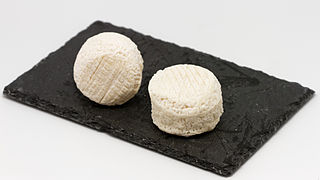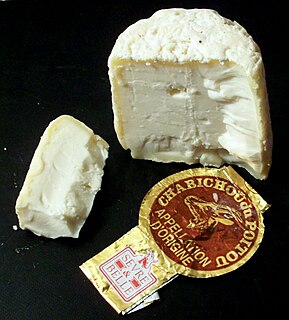
Brie is a soft cow's-milk cheese named after Brie, the French region from which it originated. It is pale in color with a slight grayish tinge under a rind of white mould. The rind is typically eaten, with its flavor depending largely upon the ingredients used and its manufacturing environment. It is similar to Camembert, which is native to a different region of France.

Goat cheese, or chevre, is cheese made from goat's milk. Goat cheeses are made in a wide variety of styles, from soft fresh cheese to hard aged cheese.

Munster, Munster-géromé, or (Alsatian) Minschterkaas, is a strong-smelling soft cheese with a subtle taste, made mainly from milk first produced in the Vosges, between Alsace-Lorraine and Franche-Comté regions in France. The name "Munster" is derived from the Alsace town of Munster, where, among Vosgian abbeys and monasteries, the cheese was conserved and matured in monks' cellars.

Comté is a French cheese made from unpasteurized cow's milk in the Franche-Comté traditional province of eastern France bordering Switzerland and sharing much of its cuisine. Comté has the highest production of all French AOC cheeses, at around 66,500 tonnes annually. It is classified as a Swiss-type or Alpine cheese.

Cantal cheese is an uncooked firm cheese produced in the Auvergne region of central France: more particularly in the département of Cantal as well as in certain adjoining districts. Cantal cheese was granted Appellation d'Origine Contrôlée certification in 1956. One of the oldest cheeses in France, Cantal dates back to the times of the Gauls. It came to prominence when Marshal Henri de La Ferté-Senneterre served it at the table of Louis XIV of France. Senneterre is also responsible for the introduction of Saint-Nectaire and Salers.

Crottin de Chavignol is a goat cheese produced in the Loire Valley. This cheese is the claim to fame for the village of Chavignol, France, which has only two hundred inhabitants.

Pont-l'Évêque is a French cheese, originally manufactured in the area around the commune of Pont-l'Évêque, between Deauville and Lisieux in the Calvados département of Normandy. It is probably the oldest Norman cheese still in production.

Saint-Nectaire is a French cheese made in the Auvergne region of central France.

Époisses, also known as Époisses de Bourgogne, is a legally demarcated cheese made in the village of Époisses and its environs, in the département of Côte-d'Or, about halfway between Dijon and Auxerre, in the former duchy of Burgundy, France, from agricultural processes and resources traditionally found in that region.

Sainte-Maure de Touraine is a French cheese produced in the province of Touraine, mainly in the department of Indre-et-Loire. It is named after the small town of Sainte-Maure-de-Touraine, in the department of Indre-et-Loire, at equal distance from westly Chinon and eastly Loches.

Chabichou is a traditional semi-soft, unpasteurized, natural-rind French goat cheese with a firm and creamy texture. Chabichou is formed in a cylindrical shape which is called a "bonde", per the shape of the bunghole of a gun barrel. and is aged for 10 to 20 days. It is the only goat cheese that is soft ripened allowed by Protected Designation of Origin regulations to be produced using pasteurized milk. Chabichou is very white and smooth, and flexible to the palate, with a fine caprine odor.

Valençay is a cheese made in the province of Berry in central France. Its name is derived from the town of Valençay in the Indre department.

Maroilles is a cow's-milk cheese made in the regions of Picardy and Nord-Pas-de-Calais in northern France. It derives its name from the village of Maroilles in the region in which it is still manufactured.

Selles-sur-Cher is a French goat-milk cheese made in Centre-Val de Loire, France. Its name is derived from the commune of Selles-sur-Cher, Loir-et-Cher, where it was first made in the 19th century.

Picodon is a goats-milk cheese made in the region around the Rhône in southern France. The name means "spicy" in Occitan.

Pouligny-Saint-Pierre is a commune in the Indre department in central France.

Fourme de Montbrison is a cow's-milk cheese made in the regions of Rhône-Alpes and Auvergne in southern France. It derives its name from the town of Montbrison in the Loire department.
 Pouligny-Saint-Pierre
Pouligny-Saint-Pierre
















